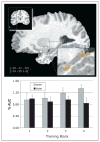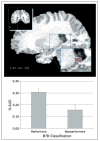An FMRI analysis of the human hippocampus: inference, context, and task awareness
- PMID: 16839289
- PMCID: PMC2078243
- DOI: 10.1162/jocn.2006.18.7.1156
An FMRI analysis of the human hippocampus: inference, context, and task awareness
Abstract
The hippocampus is critical for encoding and retrieving semantic and episodic memories. Animal studies indicate that the hippocampus is also required for relational learning tasks. A prototypical relational learning task, and the one investigated in this experiment, using event-related functional magnetic resonance imaging, is the transitive inference (TI) task. In the TI task, participants were to choose between A and B (A?B) and learned by trial and error to choose A (A > B). There were four such premise pairs during a training (A > B, B > C, C > D, D > E). These can be acquired distinctly or can be organized into a superordinate hierarchy (A > B > C > D > E), which would efficiently represent all the learned relations and allow inferences (e.g., B > D). At test there was no reinforcement: In addition to premise pairs, untrained pairings were introduced (e.g., A?E, B?D). Correctly inferring that B > D is taken as evidence for the formation of a superordinate hierarchy; several alternatives to the superordinate hierarchy hypothesis are considered. Awareness of the formation of this hierarchy was measured by a postscan questionnaire. Four main findings are reported: (1) Inferential performance and task awareness dissociated behaviorally and at the level of hemodynamic response; (2) As expected, performance on the inferred relation, B > D, corresponded to the ability to simultaneously acquire B > C and C > D premise pairs during training; (3) Interestingly, acquiring these "inner pairs" corresponded to greater hippocampal activation than the "outer pairs" (A > B, D > E) for all participants. However, a distinct pattern of hippocampal activity for these inner pairs differentiated those able to perform the inferential discrimination, B > D, at test. Because these inner premise pairs require contextual discrimination (e.g., C is incorrect in the context of B but correct in the context of D), we argue that the TI task is hippocampal-dependent because the premise pair acquisition necessary for inference is hippocampal-dependent; (4) We found B > D related hippocampal activity at test that is anatomically consistent with preconsolidation recall effects shown in other studies.
Figures







References
-
- Acuna BD, Eliassen JC, Donoghue JP, Sanes JN. Frontal and parietal lobe activation during transitive inference in humans. Cerebral Cortex. 2002;12:1312–1321. - PubMed
-
- Acuna BD, Sanes JN, Donoghue JP. Cognitive mechanisms of transitive inference. Experimental Brain Research. 2002;146:1–10. - PubMed
-
- Bransford JD, Franks JJ. The abstraction of linguistic ideas. Cognitive Psychology. 1971;2:331–350.
-
- Bustamante JA, Jordan A, Vila M, Gonzalez A, Insua A. State dependent learning in humans. Physiology and Behavior. 1970;5:793–796. - PubMed
Publication types
MeSH terms
Grants and funding
LinkOut - more resources
Full Text Sources
Medical
Research Materials

